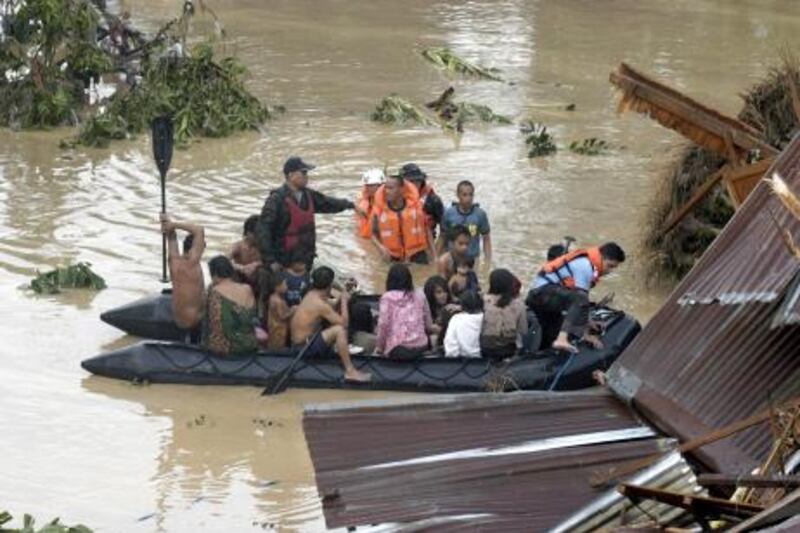MANILA // Pounding rain from a typhoon swelled rivers and sent walls of water rushing through the southern Philippines while people were asleep, killing at least 436 – many of them children – with hundreds missing, officials said yesterday.
About 100,000 people have been forced from their homes, government and army officials said.
"I can’t explain how these things happened. Entire villages were swept to the sea by flash floods," the army spokesman Colonel Leopoldo Galon said.
"I have not seen anything like this before. This could be worse than Ondoy," he said, referring to a 2009 storm that inundated the capital, Manila, killing hundreds.
Some of the dead were swept out to sea from the coastal cities of Cagayan de Oro and Iligan after Typhoon Washi, with winds gusting up to 90 kilometres an hour, hit the island of Mindanao late on Friday night, bringing heavy rain that left wide areas without power.
Col Galon said emergency workers had recovered 97 bodies, most of them children, who drowned in floods in Cagayan de Oro. At least 79 people drowned in Iligan.
The national disaster agency said five miners were also buried in a landslide.
Television images showed bodies covered in mud, cars piled on top of each other and wrecked homes.
Helicopters and boats searched the sea for survivors and bodies.
Rescue boats pulled scores from the Bohol Sea.
The Iligan mayor Lawrence Cruz said that many people were caught by surprise when water rose one metre in less than an hour.
"Most of them were already sleeping when floodwaters entered their homes," he said.
"This is the worst flooding our city had experienced in years."
The floodwaters were waist-high in some neighbourhoods that do not usually experience flooding. Scores of residents escaped the floods by climbing onto the roofs of their homes, Mr Cruz said. Those missing included the prominent radio broadcaster Enie Alsonado, who was swept away while trying to save his neighbours, Mr Cruz said.
The national disaster agency said it could not estimate crop and property damage because emergency workers, including soldiers and police officers, were evacuating families and recovering casualties.
The social welfare department said about 100,000 people were displaced and brought to more than a dozen shelters in the two cities.
One man in Cagayan de Oro said he heard a cry for help around late in the night while the floodwaters were still low. "Suddenly, there was a very strong rush of water," the man, who was not identified, told a local TV station.
Ayi Hernandez, a former congressman, said he and his family were resting in their home late Friday when they heard a loud "swooshing sound" and water quickly rose ankle deep inside his home. He decided to evacuate to a neighbour’s two-storey house.
"It was a good thing because in less than an hour the water rose to about 11 feet [3.3 metres]," the height of the ceiling of his house, he said.
The civil defence administrator Benito Ramos said 18 people had drowned in floodwaters in central Negros Oriental province, whose southern tip was nipped by the eye of the storm later yesterday.
An average of 20 typhoons hit the Philippines every year, often causing death and destruction - but mainly in the north. They are rare in the south.
Back-to-back typhoons in September left more than 100 people dead in the northern Philippines.
Washi quickly cut across the region overnight and was over the Sulu Sea by midmorning yesterday. It was then headed for Palawan province south-west of Manila and was expected to cross the narrow province before dawn today, said forecaster Leny Ruiz.
Mr Ruiz said the weather bureau’s records show storms that follow Washi’s track come only once in about 12 years.
Lucilo Bayron, vice mayor of Puerto Princesa in Palawan, told ABS-CBN television that he had already mobilised emergency crews but local officials have not ordered an evacuation "because it’s not raining and the weather is still fine here".
Mr Ramos, a former army general, said by law two army divisions – about 20,000 men – in Mindanao and part of the central Philippines are supposed to help with rescue and relief work, backed up by hundreds of local police, reservists, coastguard officers and civilian volunteers.
He could not give an estimate of how many are actually involved.
Mr Ramos said the heavy casualties in Mindanao could be attributed "partly to the complacency of people because they are not in the usual path of storms" despite four days of warnings by officials of an approaching storm.
He also said heavy rains fell on nearby Bukidnon province’s vast pineapple plantations, which sit on a plateau that drains rainfall through a river system that runs through Cagayan de Oro. Mountains near Iligan were denuded, also causing the flash floods and mud flows that swamped the city, he said.
* With Reuters





